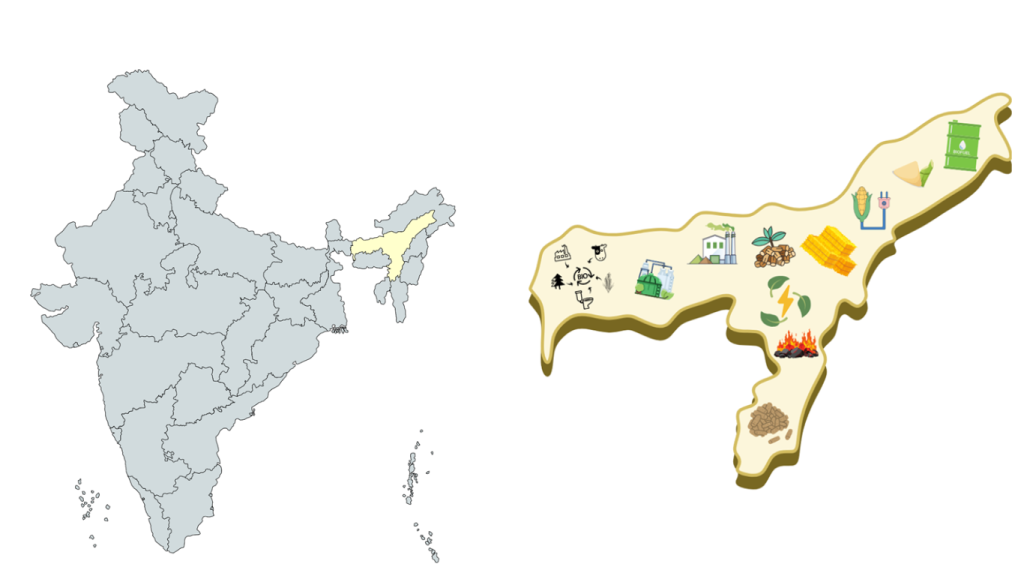
Key Questions Answered in this Section
- What are the major crops contributing to biomass feedstock production in Assam?
- Which regions in Assam are known for the cultivation of prominent crops?
- Which types of biomass residues are generated in Assam?
- What are the biomass clusters in Assam?
- How is the biomass supply chain in Assam?
- How much rice straw is generated in Assam?
- How much rice husk is generated in Assam?
- How much bamboo residue is generated in Assam?
- How much mustard stalk is generated in Assam?
- How much coriander stalk is generated in Assam?
Assam comprises a mix of urban and rural regions, with the top urban areas being Guwahati, Silchar, Dibrugarh, Jorhat, Nagaon, Tinsukia, Tezpur, Bongaigaon, Karimganj, and Dhubri. Understanding the biomass supply chain in Assam is crucial for optimizing the utilization of agri residues and enhancing the state’s bioenergy potential.
Major Crops Grown
| Crop | Production (Million Tons Per Annum) |
| Rice | 5.27 |
| Bamboo | 24 |
| Jute | 0.9 |
| Mustard | 0.2 |
| Coriander | 0.03 |

The cultivation of these crops results in substantial biomass feedstock, contributing significantly to Assam’s bioeconomy.
Residue Generation
| Crop | Residue Parts | Production (Million Tons) |
| Rice | Straw, husk | 8.8 |
| Bamboo | – | – |
| Mustard | Stalk | – |
| Coriander | Stalk | 0.009 |
Efficient management of these crop residues is essential for developing a sustainable biomass supply chain in Assam.
Significant Regions of Availability
- Rice: Kamrup, Karbi Anglong, Nagaon, Goalpara, Cachar, N.C. Hills
- Bamboo: Major growing stock found across Assam, with high annual harvested amounts
- Mustard: Lakhimpur, Kokrajhar, Sonitpur, Dhemaji, Dhubri, Barpeta, Nagaon, Karbi Anglong, Darrang, Jorhat, and Kamrup
- Coriander: Kamrup, Karbi Anglong, N.C. Hill, Nagaon, Goalpara, Cachar
identifying these biomass clusters enables targeted strategies for biomass feedstock collection and utilization.
Prominent Crops in Different Regions of Assam
Each region’s unique crop profile contributes to the diversity of agricultural residues, impacting the overall biomass availability in Assam.
| Region | Prominent Crops |
| Kamrup | Rice, Coriander, Mustard |
| Karbi Anglong | Rice, Coriander, Mustard |
| Nagaon | Rice, Coriander, Mustard |
| Goalpara | Rice, Coriander |
| Cachar | Rice, Coriander |
| N.C. Hills | Rice, Coriander |
| Lakhimpur | Mustard |
| Kokrajhar | Mustard |
| Sonitpur | Mustard |
| Dhemaji | Mustard |
| Dhubri | Mustard |
| Barpeta | Mustard |
| Darrang | Mustard |
| Jorhat | Mustard |
Utilization of Crop Residues at the Farmer’s Level in Assam
- Essential Usage for Livestock
- Residues from crops such as Banana, Groundnut, Sugarcane (top leaves), and Urad are extensively used for cattle feeding.
- Some amount of Mustard & Rapeseed residues are also utilized for feeding livestock.
- Specific Usage in Fertilizer and Handicrafts
- Residues from Banana, Urad, Jute, Groundnut, and Potato are primarily used for preparing compost manure (organic fertilizer).
- Residues of Arecanut and Jute are also used to create decorative items.
- Fuel Usage for Domestic Needs
- Around 60% of Rice residues and 35% of Mustard residues are used as domestic fuel for cooking.
- Field Preparation through Residue Burning
- Residues of Arecanut, Jute, Rapeseed & Mustard, Potato, and Urad are often burned in open fields.
- Approximately 13% of Rice residue (stubble) is burned openly to clear fields quickly for the next crop.
- Commercial Applications
Farmers generate revenue by selling crop residues to briquetting or biomass plants, adding economic value to otherwise wasted materials.
Expert Consulting Assistance for Indian Bioenergy & Biomaterials
Talk to BioBiz
Call Muthu – 9952910083
Email – ask@biobiz.in



